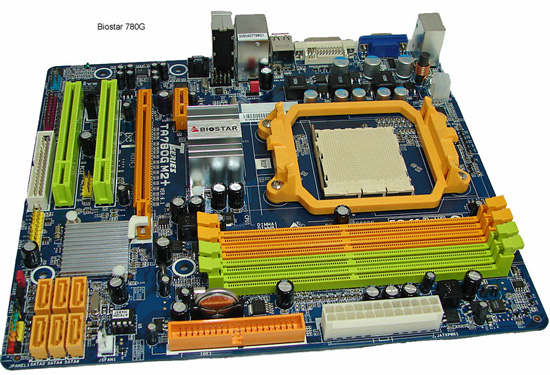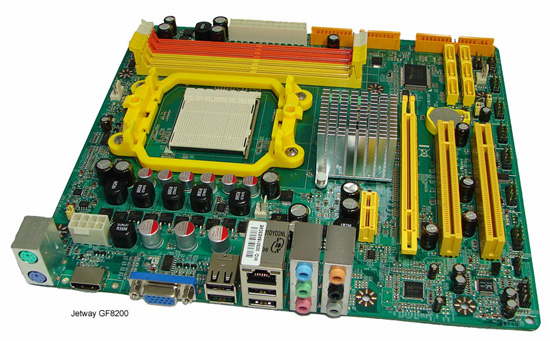Motherboards
Our case dictates a uATX form factor motherboard. Fortunately for us, the choices are numerous for the socket AM2+ format we require. Since AMD has concentrated on (or been forced to) the low end sector the past couple of years, the chipset and motherboard suppliers have responded with some very good chipsets following the AMD 690G chipset launch last year. The two primary chipsets I focused on are the AMD 780G and NVIDIA GeForce 8200/8300. The supply situation is better with the AMD 780G at this point but the GF8200/8300 is a very completive offering.
Either chipset would work for our requirements. In fact, if these systems were not using discrete video cards, I would have chosen the 780G based upon the performance of its IGP. The GF8200 holds an advantage by offering 8-channel LPCM audio over HDMI compared to two-channel for the 780G, but with recent driver changes turning off 6-channel LPCM output, NV is effectively neutering their chipset for reasons we cannot explain. In the end, based on using a discreet graphics card, either chipset was fine for our configuration.
Now that I had settled the chipset question (sort of), it was time to find the right board for the right price. The de facto standard in this market sector right now is the Gigabyte GA-MA78GM-S2H, and rightfully so. It would have been very easy to just select that motherboard and end my search quickly. However, in this market sector there are alternate choices and I like to spread my money around to other suppliers at times. I had a request from a couple of family members to build them basic "SOHO" machines so I had a little leeway in ordering several uATX boards and then choosing which one I would use.


The Gigabyte board was first on the list, but it ended up with Anand for his Home Theater construction masterpiece. Even so, some very competent choices stayed at home. The Jetway 780G PA78GT3-DG and GF8200 PN78SM3-HL, Biostar TA780G M2+, Sapphire PI-AMDRS780G, and ASRock 780G A780FullDisplayPort all were used in personal system buildups. I would like to mention that the J&W JW-RS780UVD-AM2+ and Zotac GF8300 were highly sought after based upon test results but those products were not available in the US at time of purchase. Currently, the Jetway and Biostar products are in and out of stock at various e-tailors, but the others listed were in stock at several locations today.
I planned on a smooth "exit stage left" routine without saying which motherboards are staying in my personal systems, but I am sure somebody would have noticed the lack of commitment on the subject. In the end, the Biostar 780G is in my system and the Jetway GF8200 board is in my daughter's system. How did I come to that decision? It came down to the location of the PCI Express x1 slot on each board. This small design difference changed the original plan of installing the GF8200 board in my system and I will go over that decision shortly.
The Jetway 780G and Sapphire 780G are in systems for my parents, who are both active computer nuts well into their seventies now. The ASRock 780G product ended up in another system for testing. I will explain that in another blog shortly. I will sum up the motherboard choices by simply stating that there are other choices in the market worth considering before making a purchasing decision. These brands listed today may not be from Tier-1 suppliers, nor offer the greatest amount of features or overclocking capabilities, but so far they have performed extremely well as the heart and soul in these jack-of-all trades systems.










33 Comments
View All Comments
PCMerlin - Tuesday, May 27, 2008 - link
Lightning, looking through the article he mentions Vista drivers, media streaming and other features that one would assume is only available in Vista Ultimate Edition (64-bit, of course with 8GB of RAM). Being that it is not included in the budget, one must also assume that he is transferring the OS from the original PC's, which indicates that he is using the retail, and not the OEM version.Armed with that info, users who want to build a system just like this should add another $269 to the total, based on average retailer figures.
Note: As the cost of the case is note mentioned as well, those trying to replicate the total cost of the system would need to compensate for that as well.
darkmarc - Tuesday, May 27, 2008 - link
Good article, I also went down SFF SG03 route - with Nehalem just around the corner and my ageing amd X2 creeking away, I wanted a system that wouldn't suffer obsolescence to quickly. The SFF is a great intermediate solution, once Nehalem has matured I can then turn it into home server. I went for the Asus P5E-VM mobo with Q6600, 8gb ddr2, 8800GTS (as it runs cooler then the GT) a Creative X-Fi sound card that I canabalised from my old system and two Samsung 1tb hhd's. I kept the stock cooler, went for the 600w Silverstone psu and two Noctua fans keeping it cool at the front. The Asus board lets me run the Q6600 at 3ghz without a problem so with the 8gig of ram it's great for running VM's. I have the LG GGC-H20L drive for all my Blu-ray/HD-dvd needs, hooked up to a Hyundai 24" panel. It is very quiet and has all the power I need and I don't have to worry about upgrading it as it will fulfill a secondary role.Viditor - Tuesday, May 27, 2008 - link
In most all of the build articles I've read, the one thing everyone forgets is to add the price of the OS in. Even though it's the same, many people forget that cost when they plan their next system (leads to disappointment from the unitiated).amphionuk - Wednesday, May 28, 2008 - link
Why pay for your OS?If you don't want to play the latest games, you can install Ubuntu or one of the other Linux distros for free.
drfelip - Tuesday, May 27, 2008 - link
Good article, I think SFF computers are a good option for most users, and I like the small cases a lot, but sometimes it's difficult to find reviews and comparisions of SFF cases micro-ATX boards and barebones. I think this is an area to expand!Visual - Tuesday, May 27, 2008 - link
A very nice looking case recommendation for the next part of your guide: GMC AVC-S7http://www.driverheaven.net/reviews.php?reviewid=5...">http://www.driverheaven.net/reviews.php?reviewid=5...
Not for everyone, obviously, with its single PCI card limit. But some people like smaller is better. If you go with integrated video and all you need is a tuner, this is as small as you can get. It's also possible, though more hassle, to get this with a pci-express riser instead of pci riser, so you can have a graphic card.
DXRick - Tuesday, May 27, 2008 - link
The Silverstone SG03 takes micro-ATX mobos. Why limit it to uATX?Visual - Tuesday, May 27, 2008 - link
I'm confused... uATX is micro-ATX. So what are you asking, again?Flunk - Tuesday, May 27, 2008 - link
The official short for for micro-ATX is mATX. Sometimes the greek ltter µ (Mu) is substituted for the word micro, particularly for scientific purposes. Sometimes people use u as a substitute for µ because it doesn't appear on the standard keyboard map. This is confusing (as evidenced above) and inaccurate.DXRick - Wednesday, May 28, 2008 - link
I looked it up on Newegg before replying (try it sometime).Micro-ATX is 9.6 x 9.6.
uATX is 9.6 x 8.4.